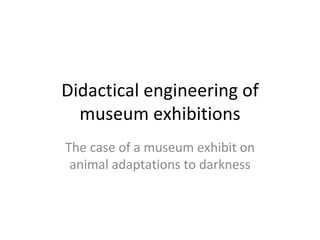
A design-based research approach to museum exhibit engineering
- 1. Didactical engineering of museum exhibitions The case of a museum exhibit on animal adaptations to darkness
- 4. Case Cave Expedition (Experimentarium, Copenhagen)
- 5. Content Cave Expedition (Experimentarium, Copenhagen) Adaptations of the blind cave beetle to its environment of permanently dark caves
- 6. Project overview Design (exhibit engineering) Enactment (visitors - exhibit) Analysis (synthesis of model) RQ: Which factors, related to the scientific content or the exhibit objectives, affect the engineering of an exhibit? RQ: Which relationships exist between the characteristics of exhibit engineering and those of visitors’ experiences? RQ: Can re-engineering of an exhibit, based on empirical findings synthesised with education theory, engender visitor experiences that better reflect the stated objectives? (Design-based research collective, 2003)
- 8. Source knowledge context Muscle cell Red blood cell Nerve cell Transposition Teaching context Prototypical animal cell (c.f. Clément, 2007)
- 9. Museographic transposition ( adapted from Simonneaux & Jacobi, 1997 )
- 10. Content Adaptations of the blind cave beetle to its environment of permanently dark caves
- 12. Cave ( environment ) Abiotic factors Biotic factors Cave beetle (organism) Morphological adaptations Physiological adaptations Behavioural adaptations clawed feet reduced eyes tricho- bothria elongated antennae elongated legs CO 2 tolerance slow, methodical movement reduced pigment reduced wings steno- hygrobia chemo- reception tactile sense prey predators enclosed space saturated atmosphere high CO 2 uneven surfaces permanent darkness pools and drips vibration detection Scientific knowledge
- 14. Knowledge ecology of the Cave Expedition exhibit
- 16. Cave (environment) Abiotic factors Biotic factors Cave beetle (organism) Morphological adaptations Physiological adaptations Behavioural adaptations clawed feet reduced eyes tricho- bothria elongated antennae elongated legs CO 2 tolerance slow, methodical movement reduced pigment reduced wings steno- hygrobia chemo- reception tactile sense prey predators enclosed space saturated atmosphere high CO 2 uneven surfaces permanent darkness pools and drips vibration detection Cave beetle (visitor) Cave (exhibit) Abiotic factors darkness enclosed space uneven surfaces Biotic factors
- 17. “ These are the types of animals you’d find in caves. These are the animals that would prey on the beetles [in the wild]” (Exhibition engineer I, 2007)
- 18. Cave (environment) Abiotic factors Biotic factors Cave beetle (organism) Morphological adaptations Physiological adaptations Behavioural adaptations clawed feet reduced eyes tricho- bothria elongated antennae elongated legs CO 2 tolerance slow, methodical movement reduced pigment reduced wings steno- hygrobia chemo- reception tactile sense prey predators enclosed space saturated atmosphere high CO 2 uneven surfaces permanent darkness pools and drips vibration detection Cave beetle (visitor) Cave (exhibit) Abiotic factors darkness enclosed space uneven surfaces Biotic factors predators transient sightless- ness Behavioural adaptations slow methodical movement recruit tactile sense
- 19. Exhibition milieu Cave (environment) Abiotic factors Biotic factors Cave beetle (organism) Behavioural adaptations slow, methodical movement tactile sense predators enclosed space uneven surfaces permanent darkness Cave beetle (visitor) Cave (exhibit) Abiotic factors darkness enclosed space uneven surfaces Biotic factors predators Behavioural adaptations slow methodical movement recruit tactile sense transient sightless- ness
- 22. What is it supposed to be, the exhibit you just visited? What makes it a cave, in your opinion? How did you find your way, inside? Exhibition milieu Cave (exhibit) Abiotic factors Biotic factors Cave beetle (visitor) Behavioural adaptations slow, methodical movement tactile sense predators enclosed space uneven surfaces permanent darkness Cave (exhibit) transient sightless- ness Abiotic factors darkness enclosed space uneven surfaces recruit tactile sense Behavioural adaptations slow methodical movement transient sightless- ness